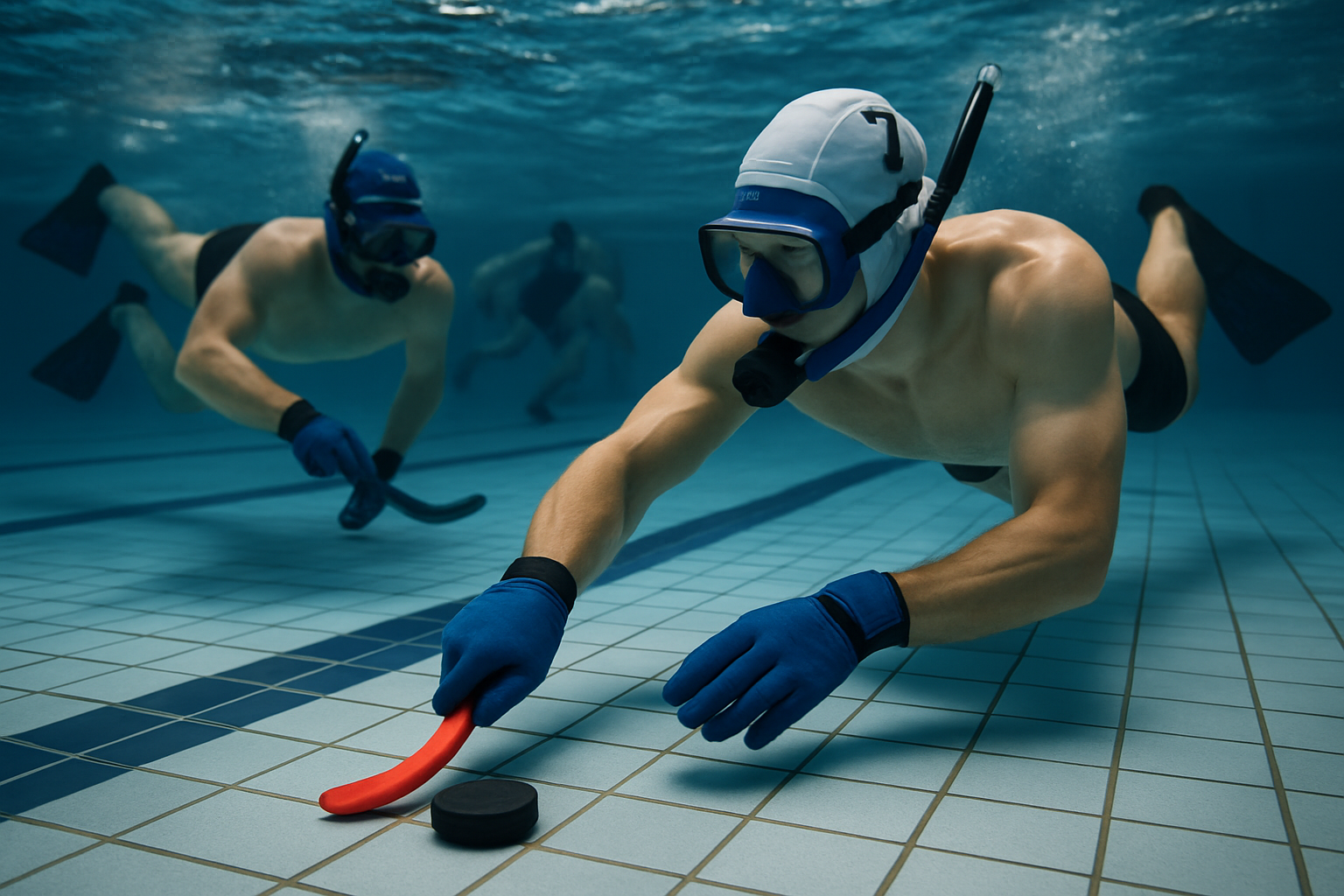Underwater Hockey: The Submerged Sport Taking the World by Storm
Imagine a sport where athletes hold their breath, dive beneath the surface, and engage in a fast-paced game of strategy and skill. Welcome to the world of underwater hockey, a unique and exhilarating sport that's gaining traction globally. This submerged spectacle combines elements of traditional hockey with the challenges of aquatic athletics, creating a truly one-of-a-kind competitive experience.

The Origins of Underwater Hockey
The inception of underwater hockey can be traced back to 1954 in Portsmouth, England. Alan Blake, a British Navy diver, conceived the idea as a means to keep divers fit and improve their ability to move and work efficiently underwater. Blake, along with other divers, developed the basic rules and equipment, laying the foundation for what would become a globally recognized sport.
Initially, the game was played with a lead puck, wooden sticks, and diving masks. As interest grew, the sport evolved, with specialized equipment being developed to enhance performance and safety. The first official competition took place in 1955 in Southsea, England, marking the beginning of underwater hockey as a competitive sport.
Throughout the 1960s and 1970s, underwater hockey spread to other countries, including Australia, Canada, and South Africa. The sport’s popularity continued to grow, leading to the formation of national and international governing bodies. In 1980, the first Underwater Hockey World Championship was held in Vancouver, Canada, further solidifying its status as a legitimate competitive sport.
The Dynamics of Play
Underwater hockey is played in a pool typically measuring 25 meters in length and 15 meters in width, with a depth ranging from 2 to 4 meters. The goal area is a 3-meter trough at each end of the pool, where teams aim to score by maneuvering the puck into the opposing team’s goal.
Players wear fins, masks, snorkels, and protective gear, including gloves, headgear, and mouthguards. The puck, weighing about 1.5 kilograms, is made of lead or plastic covered in plastic, designed to glide smoothly along the pool bottom. The stick, or pusher, is short and curved, allowing players to control and pass the puck effectively.
A typical game consists of two 15-minute halves, with a brief halftime break. Players continuously submerge and resurface, working in shifts to maintain a presence on the pool floor while allowing teammates to breathe. This constant rotation requires excellent teamwork and communication, often through hand signals and other non-verbal cues.
The sport demands a unique blend of skills, including breath-holding capacity, underwater vision, spatial awareness, and strategic thinking. Players must navigate the three-dimensional space of the pool, anticipating opponents’ moves and coordinating with teammates, all while managing their breath and exertion levels.
Physical and Mental Demands
Underwater hockey is an incredibly demanding sport, both physically and mentally. Players must possess exceptional cardiovascular fitness, muscular endurance, and breath-holding abilities. The sport requires athletes to perform intense bursts of activity while holding their breath, pushing the limits of human physiology.
Training for underwater hockey involves a combination of swimming, breath-holding exercises, and specific skill development. Athletes focus on improving their lung capacity and efficiency through techniques such as static and dynamic apnea training. These methods help players increase their breath-hold times and recover more quickly between dives.
Muscular endurance is crucial, as players must propel themselves through the water and maneuver the puck while resisting the natural buoyancy of their bodies. Strength training, particularly for the core, legs, and upper body, is essential for maintaining proper form and generating power underwater.
The mental aspect of underwater hockey is equally challenging. Players must remain calm and focused while operating in an environment where normal communication is impossible. Quick decision-making, spatial awareness, and the ability to read the game are critical skills that set apart the best underwater hockey players.
Equipment Evolution and Technological Advancements
As underwater hockey has grown in popularity, the equipment used in the sport has undergone significant evolution. Modern gear is designed to enhance performance, improve safety, and increase the sport’s accessibility to a wider range of participants.
The puck, once made of lead, is now often constructed from plastic materials that are safer and more environmentally friendly. These new pucks maintain the necessary weight and glide characteristics while reducing the risk of contamination in swimming pools.
Sticks have also seen improvements, with manufacturers experimenting with different materials and designs to optimize control and power. Carbon fiber and reinforced plastics have replaced wood in many cases, offering durability and improved performance.
Protective gear has become more sophisticated, with specially designed gloves that provide protection against impacts while maintaining dexterity. Headgear now incorporates advanced materials to protect against collisions without impeding vision or movement.
Fins, a crucial piece of equipment for underwater propulsion, have been refined to provide maximum thrust with minimal effort. Manufacturers have developed fins specifically for underwater hockey, taking into account the unique movements and requirements of the sport.
Advancements in mask and snorkel technology have also contributed to the sport’s development. Low-volume masks with wide fields of vision allow players to see the entire playing area clearly, while streamlined snorkels reduce drag and improve breathing efficiency.
Global Growth and Competitive Landscape
Underwater hockey has experienced remarkable growth since its inception, with the sport now played in over 20 countries across five continents. The World Underwater Federation (CMAS) serves as the international governing body, organizing world championships and promoting the sport’s development worldwide.
Countries such as Australia, New Zealand, and South Africa have emerged as powerhouses in underwater hockey, consistently performing well in international competitions. However, the sport’s popularity is rapidly increasing in regions like Europe, North America, and Asia, leading to a more diverse and competitive global landscape.
The World Championship, held every two years, showcases the highest level of underwater hockey competition. These events feature men’s, women’s, and junior categories, highlighting the sport’s inclusivity and appeal across different age groups and genders.
At the grassroots level, underwater hockey clubs and leagues have sprung up in cities around the world, providing opportunities for players of all skill levels to participate. Many countries have established national leagues and championships, fostering competitive play and talent development.
The sport’s growth has also led to increased media coverage and sponsorship opportunities. While still considered a niche sport, underwater hockey has gained recognition for its unique challenges and exciting gameplay, attracting attention from sports enthusiasts and adventure seekers alike.
Challenges and Future Prospects
Despite its growing popularity, underwater hockey faces several challenges as it seeks to establish itself as a mainstream sport. One of the primary obstacles is the lack of visibility for spectators. Unlike surface sports, underwater hockey action takes place beneath the water, making it difficult for audiences to follow the gameplay in real-time.
To address this issue, organizers and technology companies are exploring innovative solutions. Underwater cameras and live streaming technologies are being developed to provide clear, real-time views of the action. Some competitions have experimented with transparent pool walls or overhead screens to enhance the spectator experience.
Another challenge is the perception of underwater hockey as an extreme or niche sport. Efforts are being made to promote the sport’s accessibility and highlight its benefits, including improved fitness, teamwork skills, and water safety awareness. Many clubs offer introductory sessions and training programs to encourage newcomers to try the sport.
The future of underwater hockey looks promising, with several initiatives aimed at expanding its reach and appeal. There is a push to include the sport in multi-sport events, such as the World Games, which could provide a significant boost to its global profile.
Educational programs are being developed to introduce underwater hockey in schools and universities, targeting younger generations and creating a sustainable pipeline of future players. These programs often emphasize the sport’s unique blend of physical activity, teamwork, and aquatic skills.
Research into the physiological and psychological benefits of underwater hockey is also ongoing. Studies are examining the sport’s impact on cardiovascular health, lung capacity, and mental well-being, potentially positioning underwater hockey as a valuable form of exercise and stress relief.
Training Methodologies and Performance Optimization
As underwater hockey continues to evolve, so do the training methodologies employed by athletes and coaches. The unique demands of the sport require a multifaceted approach to training, combining elements of swimming, breath-hold diving, and traditional team sports.
Cardiovascular conditioning is a cornerstone of underwater hockey training. Players engage in a variety of swimming drills designed to improve endurance and speed. Interval training, incorporating both surface swimming and underwater sprints, helps athletes develop the ability to perform high-intensity bursts of activity while managing their breath.
Breath-hold training is another crucial aspect of preparation for underwater hockey. Athletes practice static apnea (holding breath while remaining still) and dynamic apnea (holding breath while swimming) to increase their lung capacity and CO2 tolerance. Advanced techniques such as CO2 tables and O2 tables are used to systematically improve breath-holding abilities.
Strength and conditioning programs for underwater hockey players focus on developing core stability, leg power, and upper body strength. Exercises such as squats, lunges, and plyometrics help build the explosive power needed for quick movements underwater. Core exercises enhance balance and control, crucial for maintaining proper body position during play.
Technical skills are honed through drills that simulate game situations. Players practice puck control, passing, and shooting both on land and in the water. Underwater obstacle courses and agility drills help improve maneuverability and spatial awareness.
Team tactics and strategy are developed through video analysis, dry-land walk-throughs, and in-pool scrimmages. Coaches emphasize the importance of non-verbal communication and anticipation, teaching players to read the game and make quick decisions based on their teammates’ and opponents’ movements.
Mental preparation is increasingly recognized as a vital component of underwater hockey training. Visualization techniques, meditation, and breathing exercises are employed to help players remain calm and focused in the challenging underwater environment. Some teams incorporate mindfulness practices to enhance concentration and reduce performance anxiety.
The Role of Technology in Training and Performance Analysis
Advancements in technology are playing an increasingly important role in underwater hockey training and performance analysis. Wearable devices, such as waterproof heart rate monitors and activity trackers, allow coaches to monitor players’ physiological responses during training and competition.
Underwater cameras and motion tracking systems are being used to analyze player movements and team formations. This data helps coaches identify areas for improvement and develop more effective strategies. Some teams are experimenting with virtual reality simulations to enhance tactical understanding and decision-making skills.
Biomechanical analysis tools are employed to optimize players’ techniques, from fin kick efficiency to puck handling. High-speed underwater cameras capture minute details of movement, allowing for fine-tuning of form and technique.
Software applications designed specifically for underwater hockey are emerging, offering tools for play diagramming, statistical analysis, and team management. These apps facilitate communication between coaches and players, allowing for remote strategy sessions and performance reviews.
The Social and Community Aspects of Underwater Hockey
Beyond its competitive elements, underwater hockey has fostered a vibrant and close-knit global community. The unique nature of the sport creates a strong bond among participants, transcending national and cultural boundaries.
Local clubs often serve as social hubs, organizing events and activities beyond regular training sessions. Many clubs host tournaments that combine competitive play with social gatherings, strengthening relationships within the underwater hockey community.
The sport’s inclusive nature welcomes players of diverse ages, genders, and backgrounds. Mixed-gender teams are common in many leagues and tournaments, promoting equality and mutual respect among players.
Underwater hockey has also found applications beyond competitive sport. Some organizations use it as a team-building activity for corporations, emphasizing communication, trust, and cooperation. The sport’s unique challenges make it an effective tool for developing these skills in a novel environment.
Environmental awareness is another important aspect of the underwater hockey community. Many clubs organize pool and beach clean-up events, promoting conservation and responsible use of aquatic resources. The sport’s reliance on clean water environments naturally aligns it with water conservation efforts.
Underwater Hockey in Education and Youth Development
Recognizing the sport’s potential benefits for youth development, efforts are underway to introduce underwater hockey in educational settings. Schools and community centers in several countries have begun incorporating the sport into their physical education programs.
Underwater hockey offers numerous advantages as an educational tool. It promotes water safety and confidence, crucial skills for young people. The sport’s emphasis on teamwork and non-verbal communication helps develop social skills and cooperation.
From a physical education perspective, underwater hockey provides a full-body workout that improves cardiovascular fitness, muscular endurance, and flexibility. It offers an alternative to traditional team sports, appealing to students who may not excel in or enjoy land-based activities.
The cognitive demands of underwater hockey, including spatial awareness, strategic thinking, and quick decision-making, align well with educational goals. Some educators have noted improvements in students’ problem-solving skills and ability to think under pressure after participating in the sport.
Youth underwater hockey programs often focus on skill development and enjoyment rather than competition, creating a positive introduction to the sport. Many of these programs emphasize the importance of sportsmanship, respect for teammates and opponents, and personal growth.
The Physiological Impact of Underwater Hockey
Research into the physiological effects of underwater hockey is providing insights into the unique adaptations experienced by players. Studies have shown that regular participation in the sport can lead to significant improvements in lung function and breath-holding capacity.
Players often develop increased vital capacity and improved efficiency in oxygen utilization. The repeated cycles of breath-holding and recovery during play stimulate physiological adaptations similar to those seen in freedivers and other breath-hold athletes.
Cardiovascular benefits are notable, with players showing improvements in heart rate variability and overall cardiovascular fitness. The sport’s demands for both aerobic and anaerobic energy systems contribute to a well-rounded cardiovascular workout.
Musculoskeletal adaptations include increased core strength and improved joint stability, particularly in the shoulders and hips. The constant resistance provided by water during movement helps build muscular endurance and promotes balanced muscle development.
Researchers are also investigating the potential benefits of underwater hockey for individuals with certain medical conditions. Preliminary studies suggest that the sport’s low-impact nature and unique breathing patterns may offer therapeutic benefits for people with asthma or other respiratory conditions.
Underwater Hockey and Sports Science Innovation
The unique nature of underwater hockey presents both challenges and opportunities for sports science research. Scientists and coaches are collaborating to develop innovative training methods and performance analysis techniques specific to the sport.
Hypoxic training protocols, originally developed for high-altitude athletes, are being adapted for underwater hockey players. These methods aim to improve the body’s ability to function with reduced oxygen availability, enhancing players’ underwater endurance.
Biomechanists are studying the hydrodynamics of underwater movement, seeking to optimize player positioning and puck control techniques. This research has led to refinements in equipment design and playing strategies.
Nutritional strategies for underwater hockey players are an area of growing interest. Research is exploring the optimal balance of macronutrients and hydration practices to support the sport’s unique energy demands and prevent fatigue during prolonged underwater exertion.
Sports psychologists are developing mental training techniques tailored to the underwater environment. These include methods for managing stress and anxiety while submerged, and strategies for maintaining focus and decision-making abilities under physical duress.
The Future of Underwater Hockey: Trends and Predictions
As underwater hockey continues to grow and evolve, several trends are shaping its future trajectory. The sport is likely to see increased professionalization, with more structured leagues and enhanced support for elite athletes.
Technological integration is expected to play a significant role in the sport’s development. Innovations in live streaming and underwater filming techniques may make underwater hockey more accessible to spectators, potentially leading to increased media coverage and sponsorship opportunities.
The sport’s eco-friendly nature aligns well with growing environmental consciousness. This could lead to partnerships with conservation organizations and increased visibility as a “green” sport option.
Efforts to include underwater hockey in major multi-sport events are likely to continue, with the potential for Olympic recognition as a long-term goal. This would significantly raise the sport’s profile and attract more participants and resources.
Educational initiatives are expected to expand, with underwater hockey potentially becoming a more common offering in schools and universities. This could create a broader base of players and supporters for the sport.
Research into the health benefits of underwater hockey may lead to its incorporation into fitness and rehabilitation programs. The sport’s low-impact nature and unique physiological demands make it an attractive option for diverse populations seeking novel forms of exercise.
Cross-pollination with other aquatic sports and disciplines is likely to occur, potentially leading to hybrid events or new variations of underwater hockey. This could include elements from freediving, synchronized swimming, or other pool-based sports.
As the global underwater hockey community grows, cultural exchanges and international collaborations are expected to increase. This could lead to a rich diversity of playing styles and strategies, further enhancing the sport’s appeal and complexity.
Conclusion: Diving into the Future of Underwater Hockey
Underwater hockey stands at an exciting juncture in its evolution. From its humble beginnings as a training exercise for navy divers, it has grown into a globally recognized sport with a passionate following. The unique challenges and thrills it offers continue to attract new players and push the boundaries of human performance in aquatic environments.
The sport’s future seems bright, with potential for growth in participation, technological innovation, and scientific understanding. As underwater hockey continues to develop, it promises to offer not just an exhilarating competitive experience, but also valuable insights into human physiology, team dynamics, and the possibilities of aquatic athletics.
Whether as a competitive pursuit, a fitness activity, or an educational tool, underwater hockey exemplifies the spirit of innovation and adventure that drives the evolution of sports. As it moves forward, underwater hockey will undoubtedly continue to inspire, challenge, and unite people across the globe, all united by their passion for this unique submerged spectacle.





